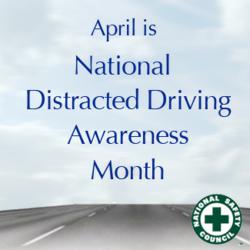

April is Distracted Driving Awareness Month, entering its fourth year. As with past years, it’s an event without an official sponsor, but law agencies are taking the opportunity to crack down on distracted drivers.
Distracted driving sweeps and educational campaigns were announced in several major states, including California, Wisconsin and Tennessee.
We should always drive with focus and to reach our destination safely. Distracted Driving Awareness Month puts safety first and text messages, arriving on time, and friends under the influence in the back seat.
According to 2016 statistics, the National Safety Council estimates as many as 40,000 people died on U.S. roadways. That’s a 6% increase over 2015 statistics and 14% over 2014. The NDC says that’s the most dramatic two-year increase in 53 years.
What can you do? Turn off your phone. Designate a sober driver. Reduce your speed. Crying children can wait until you can pull over safely. Wear your seat belt.
HOW TO OBSERVE
Take the pledge to stay focus and end distracted driving. The National Highway Traffic Safety Administration, National Safety Council, state, county and local law enforcement support campaigns increasing awareness to end distracted driving. Throughout the month of April, visit www.nsc.org or www.nhtsa.gov to learn more about what’s causing crashes, how to prevent them and what else you can do.
Use #DistractedDrivingAwarenessMonth to share on social media.
HISTORY
Distracted Driving Awareness Month is promoted by several safety organizations in the United States.
April is national Distracted Driving Awareness Month, and the East Moline Police Department is partnering with the Illinois Department of Transportation to remind motorists that if they drive with a phone in one hand, they can expect a ticket in the other.
With traffic fatalities on the rise in Illinois and across the country, the East Moline Police Department is committed to reducing easily preventable crashes caused by distractions such as texting or talking on a cellphone.
Texting while driving distracts the driver visually, manually and cognitively, putting everyone on the road at risk. Sending or receiving a text takes a driver’s eyes off the road for an average of 4.6 seconds, the equivalent of driving blind at 55 mph for the length of an entire football field. You still think you hitting into something can’t happen? Do it when not driving and save a life besides your own.
Motorists can expect to see increased patrols and enforcement zones across Illinois as part of the April 16-30 distracted driving enforcement. The East Moline Police Department will be ticketing drivers who text or use their cellphones while driving.
Not giving driving your full attention can have deadly consequences. Don’t let one text or call wreck it all: Drop It and Drive!
The Illinois Drop It and Drive program is funded with federal highway safety dollars administered by lDOT.

